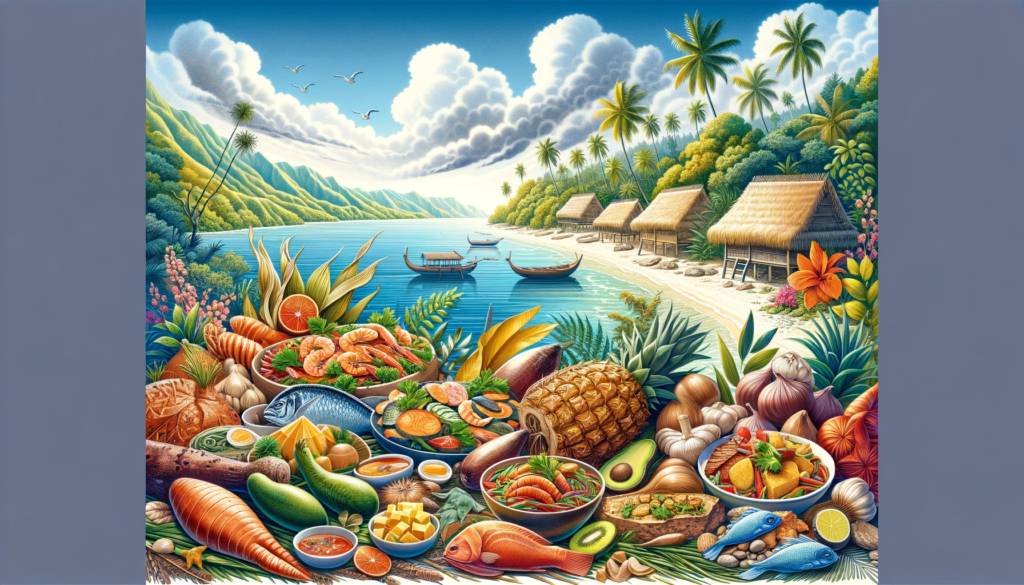Introduction to Tuvalu’s Culinary Heritage
An Overview of Tuvalu’s Unique Island Cuisine
Tuvalu, a small island nation in the Pacific, boasts a unique culinary heritage that reflects its tropical environment and oceanic resources. The diet is primarily based on the bounty of the sea, complemented by local produce that thrives in the island’s climate. Tuvalu’s traditional foods are rich with the flavors of fresh seafood, coconut, and root vegetables. Given the limited availability of imported goods, traditional cooking relies heavily on these locally sourced, sustainable ingredients. As a culinary explorer, one will discover that time-honored cooking techniques uplift the simplicity of the ingredients passed down through generations, which underscore the cultural significance of food in the Tuvaluan way of life.
Staple Ingredients in Tuvaluan Cooking
The Role of Seafood, Coconut, and Pulaka (Swamp Taro)
In the island nation of Tuvalu, the cornerstone ingredients of the local cuisine are seafood, coconut, and pulaka (also known as swamp taro). These staples are deeply intertwined into the daily diet and echo the surrounding environment. The ocean provides a plethora of seafood, from reef fish to shellfish, which are central elements of many dishes. Coconut is an all-purpose component utilized for its milk, oil, and flesh, and is indispensable in creating the creamy richness characteristic of Pacific Island cooking. Pulaka, a robust root vegetable grown in pits, is a fundamental starch that boasts a subtly sweet taste, offering both sustenance and energy, akin to the roles of potatoes or rice in other cultures.
Utilizing Local Fruits and Vegetables
Beyond the key staples, Tuvalu’s fertile land also yields various tropical fruits and vegetables that augment the richness of the island’s culinary spectrum. Breadfruit, papaya, and bananas are not just dietary mainstays but also fundamental elements in traditional recipes. These fruits are often used in sweet and savory applications, showcasing their versatility in local cuisine. Furthermore, leafy vegetables such as amaranth and island cabbage contribute essential nutrients and fresh notes to the palate, balancing the rich and often dense characteristics of staples like pulaka and coconut.

Iconic Dishes of Tuvalu
Fafaru – A Distinctively Marinated Fish Dish
Fafaru emerges as a quintessential expression of Tuvalu’s food culture, representing the island’s love for seafood with a distinctively local marination technique. This dish consists of fish traditionally marinated in a fermented brine of seawater and coconut scraps, imparting a unique umami flavor and tenderizing the flesh. Despite its pungent odor, fafaru’s taste is surprisingly delicate, revealing the skillful balance achieved through centuries-old culinary practices. This dish exemplifies an innovative use of limited resources, transforming simple seafood into a complex and flavorsome experience.
Palusami – Taro Leaves with Coconut Milk
Palusami is a beloved dish across the Pacific and holds a special place in Tuvaluan cooking. The dish features taro leaves, often layered with onions and sometimes meat or fish, then liberally doused with rich coconut milk before being wrapped tightly in banana leaves. This bundle is then traditionally baked in an underground oven, known as an ‘umu’, where it steams slowly, allowing the flavors to meld harmoniously. The result is a succulent and creamy dish, with the once coarse taro leaves transformed into a tender delicacy infused with coconut milk’s sweet, nutty essence.
Tuvaluan Banana Pudding
Tuvaluan Banana Pudding is a testament to the simplicity and ingenuity of island dessert-making. Ripe bananas are the star of this comforting treat, and, depending on the preparation, they are either mashed or layered whole, then sweetened with coconut milk or sugar, and enriched with local spices like vanilla. The pudding is then cooked until the bananas are incredibly tender, and it’s often served with a sprinkle of grated coconut on top. This dish provides a delectable end to a meal and represents the sustainable use of indigenous fruits in daily Tuvaluan life.
Ika Mata – Tuvalu’s Take on Raw Fish Salad
Ika Mata is Tuvalu’s take on the Pacific’s raw fish salad, sharing similarities with dishes like Hawaiian poke or Tahitian poisson cru. Freshly caught fish, typically tuna or reef fish, is diced and cured in lemon or lime juice, mixed with diced vegetables such as cucumber and tomato, and a generous pour of rich coconut milk. The acidity from the citrus cooks the fish to a gentle perfection, imparting a refreshing tanginess complemented by the creamy coconut dressing. This dish captures the essence of Tuvalu’s seas and is a vibrant showcase of fresh, local produce.
Traditional Cooking Methods of Tuvalu

The Use of Underground Ovens and Open Fire Grilling
Tuvalu’s traditional cooking methods are deeply rooted in the island’s history and natural resources. The underground oven, or ‘umu’, is a classic example of island ingenuity, utilizing the earth’s heat to slow-cook food enveloped in banana or breadfruit leaves. This method provides a smoky flavor to dishes like palusami and whole fish. Open-fire grilling is another common technique highlighting the natural taste of fresh seafood and local meats. Cooking over an open flame adds a charred and savory dimension and symbolizes the communal aspect of food preparation in Tuvaluan society.
Techniques for Smoking and Sun-Drying Fish
Smoking and sun-drying are preservation techniques that have served the Tuvaluan community for generations. These methods are exceptionally vital for fish, and they showcase the Tuvaluans’ adeptness at harnessing natural elements to extend the shelf life of their bountiful seafood. Smoking over coconut husks or wood preserves the fish and imparts a distinct, rich flavor. Sun-drying, achieved by laying fish out in the tropical sun on racks, produces a product that can be stored for extended periods. These techniques, born out of necessity, have become signature aspects of Tuvalu’s culinary identity.
The Role of Food in Tuvaluan Culture and Community
Food in Social Gatherings and Ceremonial Occasions
In Tuvalu, food transcends mere sustenance; it catalyzes social cohesion and cultural expression. Social gatherings and ceremonial occasions often revolve around feasts that highlight both the land and sea bounty and the community’s craftsmanship in food preparation. A traditional feast, known as a ‘kainga’, features an array of dishes embody the essence of Tuvaluan sharing and hospitality. At these gatherings, the islanders celebrate not just life’s milestones but also the daily act of coming together, sharing meals, and strengthening communal ties.
The Cultural Significance of Communal Meals
Communal meals occupy a central place in the heart of Tuvaluan culture. Eating together reinforces familial and community relationships and provides a platform for passing down traditions and values. Whether in the casual setting of a family dinner or the more structured environment of a community feast, the act of sharing food manifests Tuvaluan kinship and unity. These communal meals celebrate the islands’ spirit of inclusiveness and connectivity, with every shared dish an embodiment of collective identity and heritage.
Modern Influences on Tuvaluan Cuisine
Adaptation of Traditional Recipes to Contemporary Tastes
As with many cultures, modern influences have entered Tuvaluan cuisine. While traditional recipes remain the bedrock of the island’s culinary practices, adaptations to incorporate new ingredients and methods have emerged. The integration of foreign produce and contemporary cooking equipment are examples of this evolution. By blending the old with the new, Tuvaluan chefs and home cooks create innovative dishes that still pay homage to their culinary roots while appealing to contemporary tastes and dietary preferences.
The Impact of Global Foods on Tuvalu’s Diet
The increasing availability of global foods has notably impacted Tuvalu’s diet, introducing new flavors and altering traditional eating habits. Imported goods such as rice and canned meats are gradually complementing, if not replacing, some indigenous staples. This shift presents both challenges and opportunities: while there is concern over the potential loss of traditional foodways, there is also the potential for nutritional diversity and innovation in food preparation. Tuvaluans face the task of balancing the preservation of their culinary heritage with the integration of global influences.
Health Benefits of Traditional Tuvaluan Diet
Nutritional Value of Indigenous Ingredients and Methods
The traditional Tuvaluan diet offers significant health benefits, emphasizing fresh seafood, local fruits, and root vegetables. Indigenous ingredients like fish provide high-quality protein and omega-3 fatty acids crucial for heart and brain health. The liberal use of coconut introduces healthy fats into the diet, while root crops like pulaka offer dietary fiber and essential vitamins. Moreover, the traditional cooking methods such as steaming in an ‘umu or grilling over open fire help to retain the nutritional integrity of the food, ensuring a diet that is as nourishing as it is flavorful.
Preparing Traditional Tuvaluan Dishes at Home
Recipes for Iconic Tuvaluan Meals and Snacks
Bringing a taste of Tuvalu into your kitchen involves simple, fresh ingredients and a willingness to dive into traditional recipes. Ika Mata, with its fresh raw fish and citrusy coconut dressing, is an accessible and refreshing appetizer. Palusami can be recreated by steaming greens and coconut milk to creamy perfection. Experiment with banana pudding, which captures the essence of island sweets in every spoonful. Embracing these recipes at home provides a delightful culinary exploration, allowing anyone to experience the treasures of Tuvaluan cuisine right at their dining table.
FAQs on Traditional Food in Tuvalu
What are the key features of Tuvalu’s traditional cuisine?
The traditional cuisine of Tuvalu is characterized by its reliance on indigenous ingredients such as seafood, coconut, pulaka (swamp taro), and local fruits like papaya and bananas. Tuvaluans employ cooking methods like the ‘umu’ (underground oven), open-fire grilling, smoking, and sun-drying, all contributing to their dishes’ distinctive flavors. The cuisine represents a blend of simplicity and resourcefulness, highlighting fresh, natural flavors in every meal.
How can I incorporate Tuvaluan cooking methods at home?
Incorporating Tuvaluan cooking methods at home can start with adopting techniques like steaming, grilling, and marinating. While the traditional ‘umu’ might not be feasible, you can replicate the slow cooking process in your oven by wrapping food in banana leaves or foil. For grilling, use fresh ingredients and allow the natural flavors to shine through. Marinating seafood with citrus juices and coconut milk for a Tuvaluan twist on ceviche or poke.
Can Tuvaluan dishes be made using substitute ingredients?
While traditional ingredients are key to authentic flavors, substitutes can be used to make Tuvaluan dishes when certain items are not available. For example, spinach can replace taro leaves, and sweet potatoes can stand in for pulaka. Canned coconut milk can be used if fresh coconuts are inaccessible. The essence of Tuvaluan cuisine is its spirit of adaptability and making the most of available resources.
Are there dietary restrictions in Tuvaluan cuisine?
Traditional Tuvaluan cuisine is largely pescatarian, strongly emphasizing seafood and plant-based ingredients. There are no significant dietary restrictions stemming from religious or cultural practices. However, the diet naturally accommodates various dietary needs, as it is high in fruits, vegetables, and lean proteins from fish. Those with specific dietary restrictions can easily find or adapt Tuvaluan recipes to fit their needs.
What role does food play in Tuvaluan ceremonies and celebrations?
In Tuvaluan culture, food is more than sustenance; it is a fundamental element of ceremonies and celebrations. During events such as weddings, feasts, or community gatherings, sharing a meal is a way of marking the importance of the occasion. The food served often features a variety of traditional dishes that encourage communal eating and symbolize the unity and abundance of the community.
